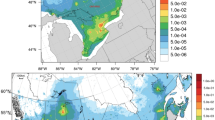Abstract
Purpose of review
Exposure to toxic substances from different environmental sources has an enormous impact on the public health, and is considered to be an important social issue. Therefore, omics approaches are used to understand relationships between diseases and environmental factors, but single omics analysis may have limitations in comprehensively interpreting specific biological phenomena. Multi-omics approaches, on the other hand, combines various single omics analyses in order to understand holistic biological mechanisms, which is sequentially assessed starting at the DNA sequence level and proceeding through epigenetic regulation, gene expression, protein expression and metabolic effects.
Recent findings
Integration of multiple omics data is invaluable for comprehensively understanding causal relationship between environmental exposure and environmental health. Furthermore, cohort based multi-omics studies are in activation worldwide and the approaches could strengthen comprehension on how environmental factors affects human health by alteration of molecular-level of biological mechanisms.
Similar content being viewed by others
References
Marsit, C. J. Influence of environmental exposure on human epigenetic regulation. J Exp Biol 218, 71–79 (2015).
Hong, J. Y. et al. Environmental risk assessment of toxicity exposure: High-throughput expression profiling. BioChip J 10, 74–80 (2016).
MacMahon, B. Gene-environment interaction in human disease. J Psychiat Res 6, 393–402 (1968).
Jirtle, R. L. & Skinner, M. K. Environmental epigenomics and disease susceptibility. Nat Rev Genet 8, 253 (2007).
Rotroff, D. M. & Motsinger-Reif, A. A. Embracing integrative multiomics approaches. Int J Genomics 2016 (2016), Published online.
Horgon, R. & Kenny, L. SAC review: Omic technologies: genomics, transcriptomics. Proteomics and Metabolomics. TOG 13, 25 (2011).
Hasin, Y., Seldin, M. & Lusis, A. Multi-omics approaches to disease. Genome Biol 18, 83 (2017).
Bradburne, C. et al. Overview of ‘omics technologies for military occupational health surveillance and medicine. Mil Med 180, 34–48 (2015).
Kan, M., Shumyatcher, M. & Himes, B. E. Using omics approaches to understand pulmonary diseases. Respir Res 18, 149 (2017).
Vlaanderen, J. et al. Application of OMICS technologies in occupational and environmental health research; current status and projections. Occup Environ Med 67, 136–143 (2010).
Gibney, E. & Nolan, C. Epigenetics and gene expression. Heredity 105, 4 (2010).
Jaenisch, R. & Bird, A. Epigenetic regulation of gene expression: how the genome integrates intrinsic and environmental signals. Nat Genet 33, 245 (2003).
Hong, J. Y. et al. Association analysis of toluene exposure time with high-throughput mRNA expressions and methylation patterns using in vivo samples. Environ Res 146, 59–64 (2016).
Lema, C. & Cunningham, M. J. MicroRNAs and their implications in toxicological research. Toxicol Lett 198, 100–105 (2010).
Lim, D. H. & Maher, E. R. DNA methylation: a form of epigenetic control of gene expression. The Obstetrician & Gynaecologist 12, 37–42 (2010).
Kim, S. Y. et al. Identification of potential biomarkers for xylene exposure by microarray analyses of gene expression and methylation. Mol Cell Toxicol 12, 15–20 (2016).
Shen, L. et al. DNA methylation and environmental exposures in human hepatocellular carcinoma. J Natl Cancer Inst 94, 755–761(2002).
Hirst, M. & Marra, M. A. Next generation sequencing based approaches to epigenomics. Brief Funct Genomics 9, 455–465 (2010).
Zhang, L. et al. Systems biology of human benzene exposure. Chem Biol Interact 184, 86–93 (2010).
Portela, A. & Esteller, M. Epigenetic modifications and human disease. Nat Biotechnol 28, 1057 (2010).
Ma, L. et al. Histone methylation in nickel-smelting industrial workers. PloS One 10, e0140339 (2015).
Vaissière, T., Sawan, C. & Herceg, Z. Epigenetic interplay between histone modifications and DNA methylation in gene silencing. Mutat Res, Rev Mutat Res 659, 40–48 (2008).
An, Y. R. et al. Functional analysis of endocrine disruptor pesticides affected transcriptome and microRNA regulation in human hepatoma cell line. Mol Cell Toxicol 10, 393–400 (2014).
Sturchio, E. et al. Arsenic exposure triggers a shift in microRNA expression. Sci Total Environ 472, 672–680 (2014).
Vrijens, K., Bollati, V. & Nawrot, T. S. MicroRNAs as potential signatures of environmental exposure or effect: a systematic review. Environ Health Persp 123, 399 (2015).
Dong, Z. & Chen, Y. Transcriptomics: advances and approaches. Sci China Life Sci 56, 960–967 (2013).
Wild, C. P., Scalbert, A. & Herceg, Z. Measuring the exposome: a powerful basis for evaluating environmental exposures and cancer risk. Environ Mol Mutagen 54, 480–499 (2013).
McHale, C. M., Zhang, L., Hubbard, A. E. & Smith, M. T. Toxicogenomic profiling of chemically exposed humans in risk assessment. Mutat Res, Rev Mutat Res 705, 172–183 (2010).
Clish, C. B. Metabolomics: an emerging but powerful tool for precision medicine. Molecular Case Studies 1, a000588 (2015).
Kan, Z. et al. Multi-omics profiling of younger Asian breast cancers reveals distinctive molecular signatures. Nat Commun 9, (2018), Published online.
Mesnage, R. et al. Integrated transcriptomics and metabolomics reveal signatures of lipid metabolism dysregulation in HepaRG liver cells exposed to PCB 126. Arch Toxicol 92, 2533–2547 (2018).
Koshiba, S. et al. Omics research project on prospective cohort studies from the Tohoku Medical Megabank Project. Genes Cells 23, 406–417 (2018).
Maitre, L. et al. Human Early Life Exposome (HELIX) study: a European population-based exposome cohort. BMJ Open 8, e021311 (2018).
Author information
Authors and Affiliations
Corresponding author
Rights and permissions
About this article
Cite this article
Koh, E.J., Hwang, S.Y. Multi-omics approaches for understanding environmental exposure and human health. Mol. Cell. Toxicol. 15, 1–7 (2019). https://doi.org/10.1007/s13273-019-0001-4
Received:
Accepted:
Published:
Issue Date:
DOI: https://doi.org/10.1007/s13273-019-0001-4




